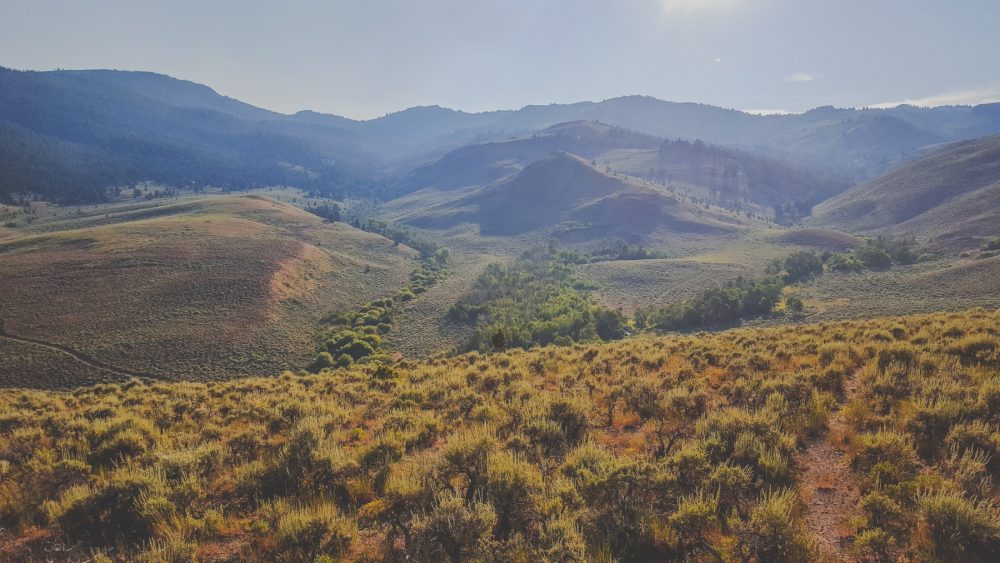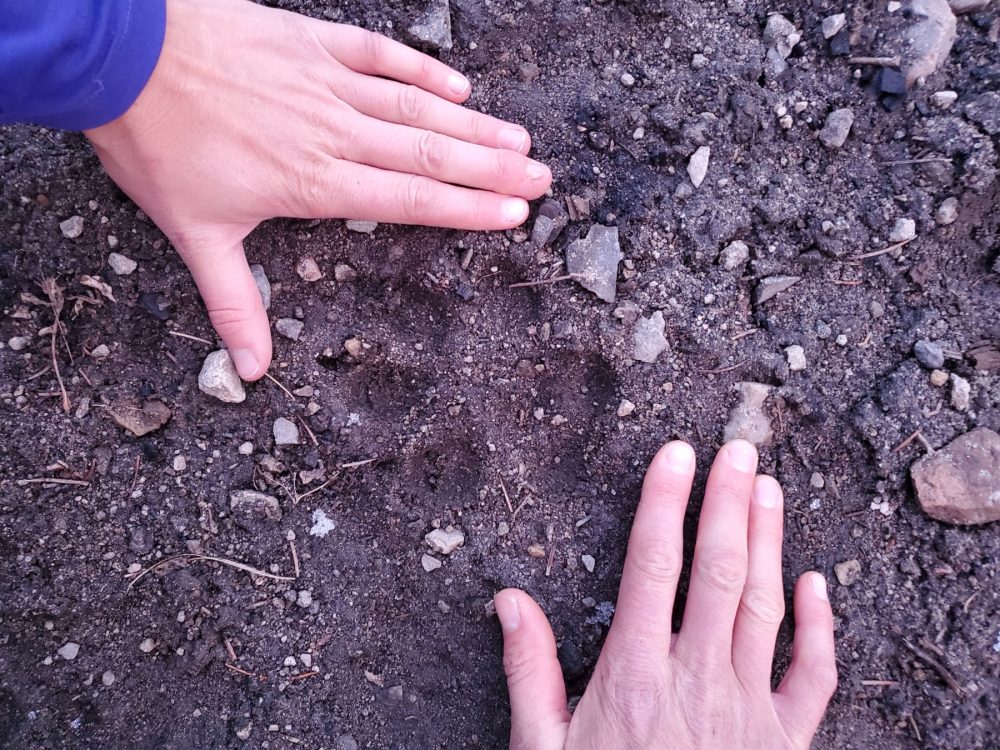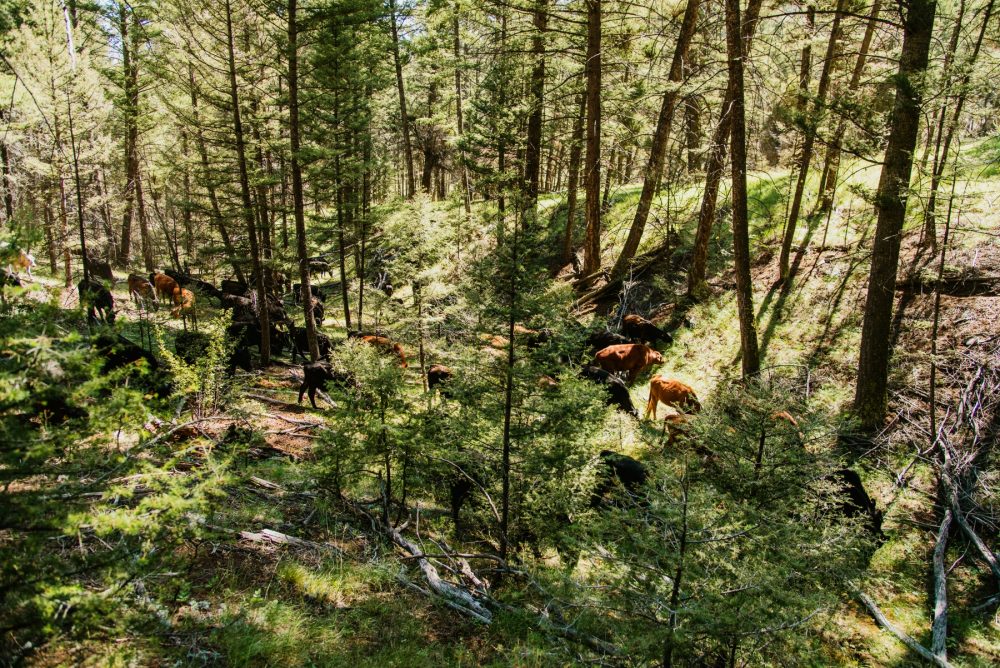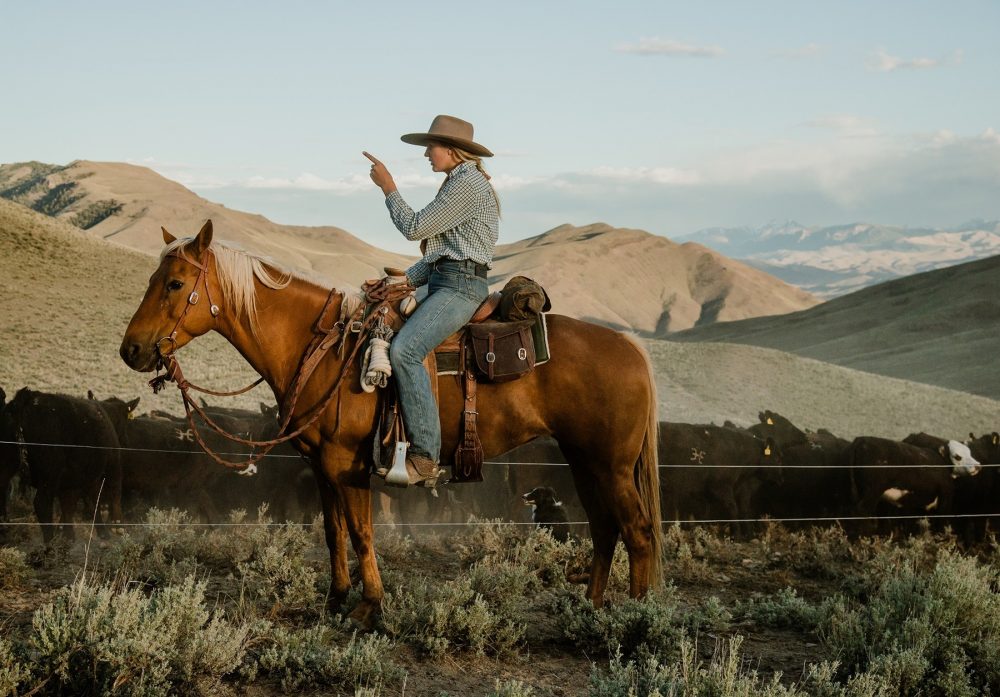It was a cryptic message, but I knew what it meant immediately. When I read the text, the two-week open window that had been a pesky nuisance in my mind finally slammed shut. I reread the satellite phone message from daughter Linnaea: “Got them loaded and about to drive out.”
That’s it. Out of the blue. Up until then, it had been radio silence all day. No cell service, and she probably stuck the SAT phone back in the saddlebag.
Yesterday, it was a tired Darrin and Steph and their boys who spotted them after a day of pulling noxious weeds by hand (can’t spray when you’re organic!). They found them a way off the two track out of Big Hat Canyon in the middle of nowhere. Darrin stopped and checked them out with the binoculars. Yep. Yellow tags. Three recalcitrant quitter steers.

They’ve been the ones that have been keeping me awake at night. I never mentioned it to my bedside partner, my wife, Caryl, until today. I jogged over to her office (we share a bed but can’t share an office because of extreme personality and organizational differences) and told her the news.
“They’ve been keeping me up at night, but I didn’t want to tell you,” I said.
“Me too.” She smiled with relief.
Three steers, loaded in Linnaea’s stock trailer with two saddle horses. They herded them back to the farthest limits of where our gooseneck stock truck and trailer could get up the rock and gully road that is pasted to a mountainside, and carefully and quietly worked them up to the trailer end-gate. Then, they applied the perfect amount of pressure with Clyde, the border collie and two of them on horseback and convinced the cattle to step up into the trailer for the long and bumpy ride back to civilization, if you would call the Pahsimeroi Valley that.
It was an all-day affair, but this puts our count exact. We have them all. Every one of the 439 head that we trailed up there, across rivers, creeks, canyons, and mountains, over 700 miles of grazing over 90 days. They’re finally back home in the valley.
Whenever this happens, which is most years nowadays, we are so grateful.
It didn’t used to be that way. This is our 7th year of what we call “inherding”, where we herd the cattle all day, and yard them at night near our camp. Every year before inherding, we came up short of cattle in the fall. Or we might find them all, but it would take much of the fall to located them. Finding cows on horseback in deep snow in December was not uncommon. They were happy to see that hay pile.
But that was before the wolves.

Even without the relatively recent threat of wolf predation, there is lot that could go wrong. There’s cliffs, rattlesnakes, cougars, bears, lightning, wildfire, poisonous plants, and pneumonia, to name a few. Or, just plain lost. There are virtually no fences worth anything for hundreds of square miles. Yearling cattle like ours simply don’t know their way back home like an older cow would. They just fade away into the literal woodwork; the woods of the endless forests of Central Idaho that literally go on for 100s of miles. There is just one ramshackle snowdrift and migrating elk tortured fence between our range and the largest wildland complex in the lower 48 states: about 10,000 square miles. Hardly something that can contain cattle.
It’s not like they’d get very far. I’m pretty certain the wolves would eat them first.
The big canines were watching us, stalking us; our silent partners during the last several weeks of the summer. We’d hear them howling in the night just above camp. We saw tracks all over Iron Mountain Camp the day after we had packed up and moved everything to a new camp. I pictured them in my mind’s eye, wolf pack scattered around our “leave no trace” camp. But with their noses to the ground, they saw all, from the smell of our bare feet on the pine needle duff after taking boots off to the place where we spilled a few drops of our precious morning coffee.
A few days later, a firewood cutter spotted one big gray wolf quietly making his across the forest just a hundred yards above the new camp location, Pass Camp, as some of us were shoeing horses. One of our riders spotted another tawny gray on the edge of the herd while out grazing one day. Wolf loped off nonchalantly after making eye contact with him on horseback.
It was like they were wondering if we humans were permanent fixtures up there. Fact is, in some ways we were, at least for the summer. It is exactly one of the reasons we camp with our critters.
Before setting up camp with cows 7 years ago, every year, we used to come up short. Our neighbors would call us. I vividly recall one call in particular: “Found one of your cows up the North Fork the other day; at least I think she was. Yellow ear tag, right?”
“Yep. Yellow.” And I’m thinking he found a live cow. Like living, breathing, walking, grazing. Beautiful black Angus Alderspring; glossy cow-coat in sunshine way up the North Fork in belly deep green grass, living her dream. By gum, she sure traveled! Happy cow!
Then there was this from the phone: “Well she’s about totally eaten. Reckon them wolves will finish her off in a day or so.”
After almost dropping the phone, I got my head back together and shifted gears into the grisly picture after an uncomfortable pause: “Yep. True story. Thanks for the call.” He was right. A pack of the hungry 120 lb canines could annihilate a 1200 lb cow in a day. With massive and strong jaw musculature, they could consume bones and all.
Or “things going wrong” could mean that they fell off a cliff. On one July day in 2007, long before we herded and lived with our cattle, I was riding horseback through some thick fir forest along some of the occasional cliffs in Big Hat Canyon when I heard a twig snap. I turned toward the sound, and I found one old girl who must have fallen, perhaps after being pursued by a predator. She was an older cow (on Alderspring that is probably around 14 years old), with a nice sized calf on her side. The black, brockle cow must have crashed in the goat rocks somewhere, as her lower right leg was recently and hopelessly shattered.
I judged quickly as I slowly unsnapped my holster. The calf was old enough to make it without mom, and would connect with the herd nearby (he did). Mom was in dire straits. Her leg was irreparable, especially given her mature weight. Besides, there was no place nearby I could get a stock trailer in here. It was enough; the die was already cast.
I stepped off my mare, and haltered horse to my lariat, giving her 35 feet of lead rope, and she put head down to grazing. The long rope was so I could easily pick her up if she started with the pistol report. I stepped 50 feet away from her toward the cow, now looking right at me. I quietly drew my .357 revolver and squeezed a round off and tipped her over instantaneously. One shot. Instant. Pain over. Life over. One in my care, gone.
I never get over these things. I remember every time I’ve had to do this, and thank God, there isn’t many.
But there is life and death always, and a way to look at things that in part can redeem. Just a little. Words drifted from the cobwebs of memory, quipped by a very close ranching friend of Caryl and mine, Donna, who has since passed on: “The coyotes gotta eat, too, Glenn.” And so they did and do.
As I reholstered, and picked up my still grazing mare, I reflected on the fact that if we were trailing the herd through here, this wouldn’t have happened. We could avoid rocks. And so, started by a lesson taught to us by the wolves who were turning out to really like our grass fed beef, now we do. We steer clear of brutally tough terrain to protect them; especially their feet. Cows aren’t made to scale cliffs like goats do.
And we keep them together in a herd, keeping them safe from predators, poisonous plants, lightning and anything else we encounter.
But despite our best efforts, every now and then, we’ll have a problem that arises with the herd. Maybe one of us humans misjudges the time, or a cloudy front slides in, and the light gets short. Darkness comes on early. The bunch stretches out in the dusk of oncoming night, maybe over a half a mile or so, and a few bail off into a thick, timbered bottom. With only 3 or 4 riders, we may miss them. Part of herding is trusting this one assumption: cattle are highly social animals, and there’s no such thing as a reclusive introvert in cattle.
And it’s true. We’ve never had just one animal wander off. They always do it in pods, of usually 10 or so, but sometimes 3 or 4. They’ll just get separated. And that’s that.

Melanie is the best counter we have (it’s really not that easy!) and she came up 2 or 3 short on good counts coming into camp over the last week or so. So we were pretty certain we were missing a few. I was frustrated; I had been dang sure we had kept the bunch together. Crap, we had enough good riders on the string this year. How could some be missing? Did we miscalculate along the way somewhere?

And so, sleepless nights come. Not all night. But part of it. I pray, while lying there, and while driving along the endless curvy road along the Salmon River at night, and whenever the thought comes to me. It’s a sort of “Hail Mary” utterance, but I really don’t think God judges us for it. He hears hearts. Empty words, not so much.
“GOD! (as if I need to get his attention) Keep them critters safe from wolves up there. Bring ’em home, please.”
That’s all there is to it. Because I know that there, up in Big Hat are the “big dogs”– wolves tracking, stalking; 120 lbs of sinew and muscle that have got to eat. A pack of 100% carnivores. Their passion is protein.
It’s startlingly real to me this year. This is the first year since we began inherding that the wolves have come in so close to our camps, and even with us gone, they can smell cattle from 10 miles away and track them for 30. And once we brought the rest of the herd home, we were no longer in camp, on the ground, a human deterrent presence. In the 2 weeks since, we’ve been trying to find them, but to no avail. Darrin and Jake probably covered over 100 miles of rattly, rocky, two-track paths in a pickup and dirt bike. Zero.
But this afternoon, as the flaming bronze, late August sun slipped into the smoky horizon, Linnaea, Darrin, Steff and the boys rolled in with cargo in their stock trailer: two tired saddle horses and 3 yellow tagged steers. Steers happily jumped out and put their heads in a waiting hay pile. Home. The last of the 439.
I’m grateful. Happy Trails.







Catherine Cain
Karma!
Shirley
No other rancher is willing to do the work that you do. I so admire your family and your ranch hands. I pray for your strength and will to continue on this journey of soil regeneration and continual care of your precious beeves.
Shari Verburg
A job well done! I love reading about your journey and seeing the pictures.
Den Hall
This is the first story I have read since subscribing. It is overwhelming. The dedication, the knowledge, the hard work! I cannot find adequate words to describe my admiration. And here I thought the ‘American Cowboy’ was an extinct myth. Now I know he/she still exists on the Alderspring Ranch.
Deb Olsen
There is such a depth to your profession that I can’t even begin to wrap my mind around it. I am so impressed with all of the things that you handle on a daily basis and I know that other ranchers don’t invest the same time as you guys do. I will keep you all in my nightly prayers for continued strength and perseverance, thank you for everything you do for all of us, I realize it’s not just a quick buck for you but that you’re spiritually driven.
Daryl Hunter
An interesting path you have traveled putting this operation together. I just got lost in your social network from a video in instagram about range management, went to YouTube so I could get the embed code for an article I have on the importance of public land ranching as ranchers are the keepers of our green space. I had to google your ranch, and now I’m on your blog.
I’d love to drop in for a cup of coffee sometime. Cheers
Daryl L. Hunter
Caryl Elzinga
Daryl–I’ll respond to your email! Thanks for your note. See you on email! -glenn
Everett Hawthorne
I am wondering what your alls horse program looks like? Do your hands supply their own strings or do you supply the horses? And if you do, do you raise your own or buy each horse?
And if you do raise your own what is your philosophy on how to raise them? Do you let them graze with your cattle or keep them separate?
Also where do you keep horse out on the range in camp? And how many horse per rider do you usually have.
I am very interested in your in herding program and I’ve been researching holistic land management. But I am very much in love with horses and to me I can not have cows without horses or vise versa. So I’ve been trying to come up with an idea on how to raise the two together while still pursuing a herding type of management.
Thank you for your input.
-Everett
Caryl Elzinga
Hi Everett, we supply all the horses for the crew! We’ve raised & started some that we purchased as weanlings or yearlings from a neighbor, others we’ve purchased usually as unstarted 3 or 4 year-olds and then started. For the ones we’ve raised from weanlings/yearlings, whether they graze with the cattle depends a lot on their nutritional needs. We like horses that are pretty easy keepers, so even the young ones would quickly become overweight if given the free-choice high quality grass that we provide our cattle. Instead, we put most of the horses in a dry lot during the day and then turn them out on a slightly less high-quality pasture to graze at night. People think we’re starving our horses doing this–trust me, many of them are still overweight even on this limited regimen. For the young ones, the hard keepers, or the very old retired ones, we keep them separate so they can have more continuous access to grass.
When on the range, we build a temporary hotwire pasture near camp and move it every few days. We only stay in a camp for about 7-10 days, so sometimes one pasture can hold them the entire time depending on the forage in that area. We have 2-3 horses for every rider. Our goal is to ride a horse only every other day at most (giving them one day on, one day off), so we want to have more than 2 per rider to provide a horse time to recover from any injuries or saddle sores if needed. Hope that helps!